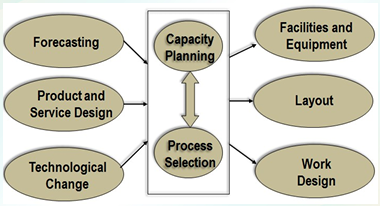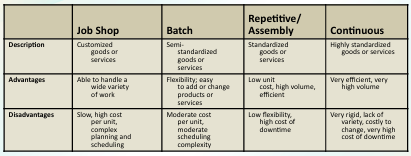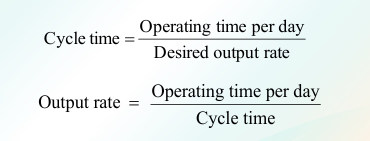[POM-TQM] Finals - (4) Process Selection and Facility Layout
1/40
There's no tags or description
Looks like no tags are added yet.
Name | Mastery | Learn | Test | Matching | Spaced |
|---|
No study sessions yet.
41 Terms
Process Selection
Refers to deciding on the way production of goods or services will be organized
Process Selection and System Design

Capital Intensity
The mix of equipment and labor that will be used by the organization
Process Flexibility
The degree to which the system can be adjusted to changes in processing requirements due to such factors as:
• Product and service design changes
• Volume changes
• Changes in technology
Two key questions in process selection
1. How much variety will the process need to be able to handle?
2. How much volume will the process need to be able to handle?
Types of Processing

Sustainable Production of Goods and Services
There is increasing pressure for organizations to operate sustainable production processes
Sustainable Production
According to the Lowell Center for Sustainable Production, it is the creation of goods and services using processes and systems that are: non-polluting; conserving of energy and natural resources; economically efficient; safe and healthful for workers, communities, and consumers; and, socially and creatively rewarding for all working people.
Process Technology
Methods, procedures, and equipment used to produce goods and provide services
Information Technology
The science and use of computers and other electronic equipment to store, process, and send information
The Need to Manage Technology
Process technology and information technology can have a profound impact on:
• Costs
• Productivity
• Competitiveness
Automation
Machinery that has sensing and control devices that enable it to operate automatically
• Fixed automation
• Programmable automation
• Flexible automation
Programmable Automation
Involves the use of high-cost, general-purpose equipment controlled by a computer program that provides both the sequence of operations and specific details about each operatio
Computer-Aided Manufacturing (CAM)
The use of computers in process control, ranging from robots to automated quality control
Numerically Controlled (N/C) Machines
Machines that perform operations by following mathematical processing instructions
Robot
A machine consisting of a mechanical arm, a power supply, and a controller
Various types of Robots
• Robots that follow a fixed set of instructions
• Programmable robots
• Collaborative robots, also known as cobots
Flexible automation
Evolved from programmable automation. It uses equipment that is more customized than that of programmable automation. A key difference between the two is that flexible automation requires significantly less changeover time.
FMS (Flexible Manufacturing System)
A group of machines designed to handle intermittent processing requirements and produce a variety of similar products
CIM (Computer Integrated Manufacturing)
A system for linking a broad range of manufacturing activities through an integrated computer system
Facilities Layout
The configuration of departments, work centers, and equipment, with particular emphasis on movement of work (customers or materials) through the syste
The Need for Layout Planning
• Inefficient operations
• High cost
• Bottlenecks
• Accidents or safety hazards
• Changes in product or service design
• Introduction of new products or services
• Changes in output volume or product mix
• Changes in methods or equipment
• Changes in environmental or other legal requirements
• Morale problems
Basic Objectives of Layout Design
Facilitate a smooth flow of work, material, and information through the system
Supporting Objectives of Layout Design
• Facilitate product or service quality
• Use workers and space efficiently
• Avoid bottlenecks
• Minimize material handling costs
• Eliminate unnecessary movement of workers or material
• Minimize production time or customer service time
• Design for safety
Basic Layout Types
• Product layouts
• Process layouts
• Fixed-position layout
• Combination layouts
Product Layout
Layout that uses standardized processing operations to achieve smooth, rapid, high-volume flow
Advantages of Product Layouts
• High rate of output
• Low unit cost
• Labor specialization
• Low material handling cost per unit
• High utilization of labor and equipment
• Established routing and scheduling
• Routine accounting, purchasing, and inventory control
Disadvantages of Product Layouts
• Creates dull, repetitive jobs
• Poorly skilled workers may not maintain equipment or quality of output
• Fairly inflexible to changes in volume or product or process design
• Highly susceptible to shutdowns
• Preventive maintenance, capacity for quick repair, and spare-parts inventories are necessary expenses
• Individual incentive plans are impractical
Process Layout
Layouts that can handle varied processing requirements
Advantages of Process Layout
• Can handle a variety of processing requirements
• Not particularly vulnerable to equipment failures
• General-purpose equipment is often less costly and easier to maintain
• It is possible to use individual incentive systems
Disadvantages of Process Layout
• In-process inventories can be high
• Routing and scheduling pose continual challenges
• Equipment utilization rates are low
• Material handling is slow and inefficient
• Reduced spans of supervision
• Special attention necessary for each product or customer
• Accounting, inventory control, and purchasing are more involved
Fixed Position Layout
Layout in which the product or project remains stationary, and workers, materials, and equipment are moved as needed
Cellular Production
• Layout in which workstations are grouped into a cell that can process items that have similar processing requirements
• Groupings are determined by the operations needed to perform the work for a set of similar items, part families, that require similar processing
• The cells become, in effect, miniature versions of product layouts
• Enables companies to produce a variety of products with very little waste
Group Technology
The grouping into part families of items with similar design or manufacturing characteristics
Goal of a Product Layout
To arrange workers or machines in the sequence that operations need to be performed
Line Balancing
The process of assigning tasks to workstations in such a way that the workstations have approximately equal time requirements
Cycle Time
The maximum time allowed at each workstation to complete its set of tasks on a unit
Formula of Cycle Time

Precedence Diagram
A diagram that shows elemental tasks and their precedence requirements
Balance Delay
Percentage of idle time of a line
Efficiency
Percentage of busy time of a line